The highs and lows of Michael Clarke

Going into the final Test of his career, Michael Clarke needs 222 runs (assuming he is dismissed twice) to lift his career average to 50; if he is dismissed once, he needs 172. Given that he has been in wretched form throughout this series and has an aggregate of 117 in eight innings, it seems highly unlikely he will get there. On the other hand, he needs 45 in two innings to ensure the average doesn't dip below 49. If he does score between 45 and 221 runs in two completed innings, he will become only the fourth batsman to play 100-plus Tests and fall less than one run short of an average of 50.
That, in a strange way, also encapsulates Clarke's career. At various times in his career he seemed within touching distance of greatness, but most experts would agree that ultimately he fell marginally short, despite being the fourth-highest run-getter in Tests for Australia; a superb batsman when in full flight, but in the overall analysis not quite in the league of a Ricky Ponting or a Sachin Tendulkar or a Brian Lara.
A break-up of Clarke's career stats shows some inconsistency, with periods of high averages interspersed with periods when his average dipped below 40. That inconsistency is probably the difference between his achieving legendary status as a batsman and stopping just short of it.
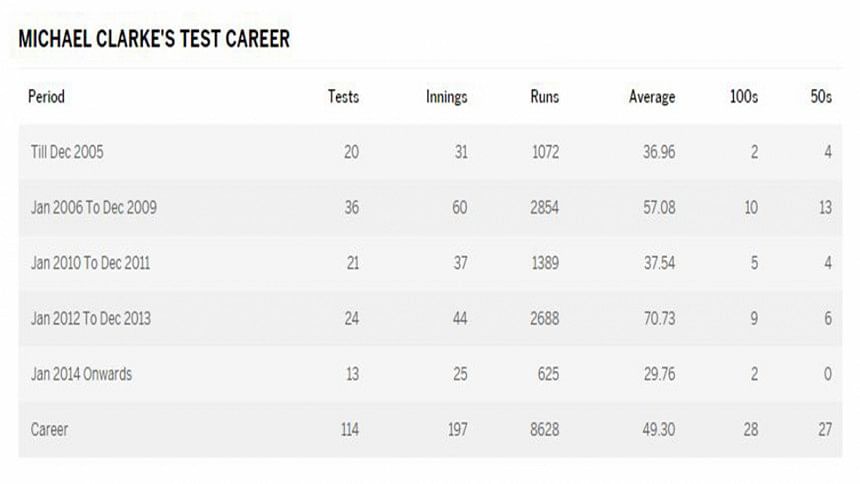
Even so, in the eight-year period from the beginning of 2006 to the end of 2013, Clarke was clearly among the top batsmen in the world: among the 31 batsmen who scored 3000 or more runs during this period, only three - Kumar Sangakkara, Shivnarine Chanderpaul and Younis Khan - had a better average. That period also includes 2012, a year when he scored 1595 runs at an average of 106.33.

However, over the entire period of his career, Clarke's average of 49.30 is only tenth out of 28 batsmen who've scored at least 4000 runs during this period.
One aspect of Clarke's batting which has always stood out has been his ability to convert fifties into hundreds - his very first Test innings was 151, against India in Bangalore. Even when he had his lean spells - in 2010-11, and then again in the last year and a half - he has still maintained an excellent conversion rate. In the last year and a half Clarke has generally struggled for runs, but on the two occasions when he has reached 50, he has gone on to hundreds, getting a magnificent 161 not out against South Africa in Cape Town, and 128 against India in Adelaide. His ratio of 1.04 hundreds per 50 (28 hundreds, 27 fifties) is fourth among all batsmen who've got at least 15 hundreds. Only Don Bradman, Clyde Walcott and Mohammad Azharuddin have better conversion rates.
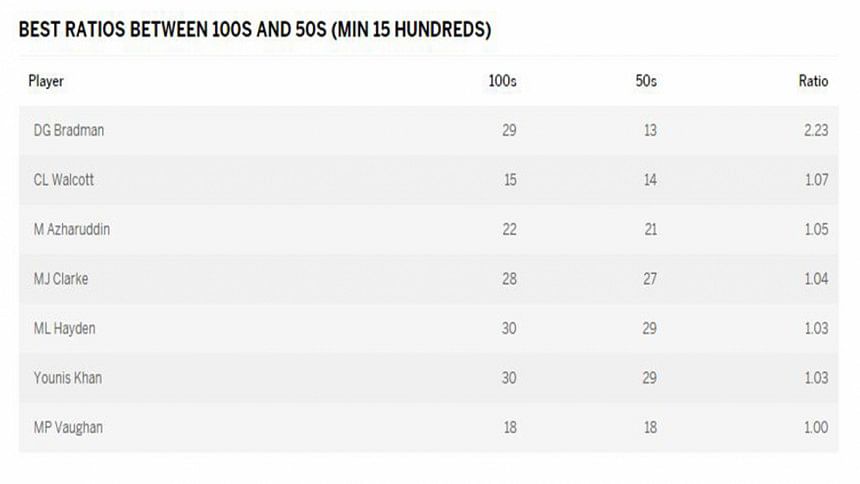
The home-away discrepancy
Many batsmen with long careers tend to have fairly even numbers across different parameters. Michael Clarke wasn't one of them. His home-away numbers, as well as his stats at No. 4 and No. 5, contrasted significantly.
At first glance, Clarke comes across as a home bully - he averaged 62.05 at home, and 39.74 away. He scored a century every three Tests at home, and one every five-and-a-half Tests away. Among Australian batsmen who played at least 50 innings at home, Clarke's average of 62.05 is next only to Don Bradman's 98.22. However, his away average is 17th out of 29 Australian top-order batsmen who played at least 50 innings overseas. Among 28 batsmen who've scored at least 8000 Test runs, the difference between Clarke's home and away average (home average minus away average) is second-highest, next only to Mahela Jayawardene's 22.35. (The numbers in the table below exclude Tests against Zimbabwe and Bangladesh.) In comparison, the difference for Ponting is 10.48, for Lara 10.58, for Kallis 5.17, for Sangakkara 7.22. Some of the other greats have a better average away than at home: for Tendulkar the difference is -2.10, for Dravid -2.29, for Steve Waugh -8.85, and for Allan Border -10.63.
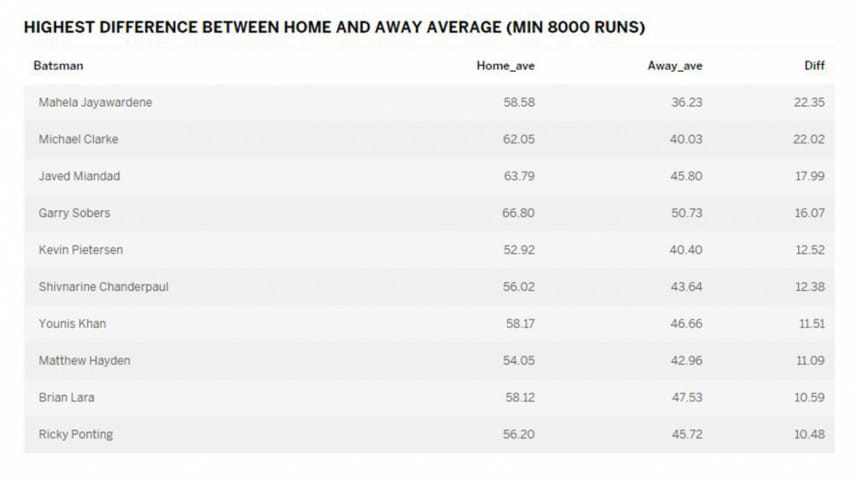
However, check out Clarke's stats in each country and something different emerges: he has played more than two Tests in six overseas countries, and in each of them he averages at least 39; in three countries - India, England and South Africa - he averages between 40 and 41. Batsmen with higher overseas averages have often struggled in one country - Ponting averaged 26 in India, Lara 33 in India (three Tests) and 36.90 in New Zealand (seven Tests), Kallis 35.33 in England (15 Tests) and Sri Lanka (five Tests), Dravid 29.71 in South Africa (11 Tests) and 33.10 in Sri Lanka (12 Tests), Inzamam 30.87 in Australia and 31.78 in South Africa (eight Tests each), Sangakkara 35.75 in South Africa (eight Tests) and 36.50 in India (six Tests), and Jayawardene less than 40 in Australia, New Zealand, England, South Africa and the UAE. (Tendulkar was the exception, averaging at least 40 in every country he played in.) However, they all compensated by averaging well over 50 in another overseas country. Clarke didn't average more than 50 in any overseas country - his best was 49.50, in New Zealand - but there was also no single country where he did poorly. The gap between his home and away average is also partially a function of his extremely high home average.
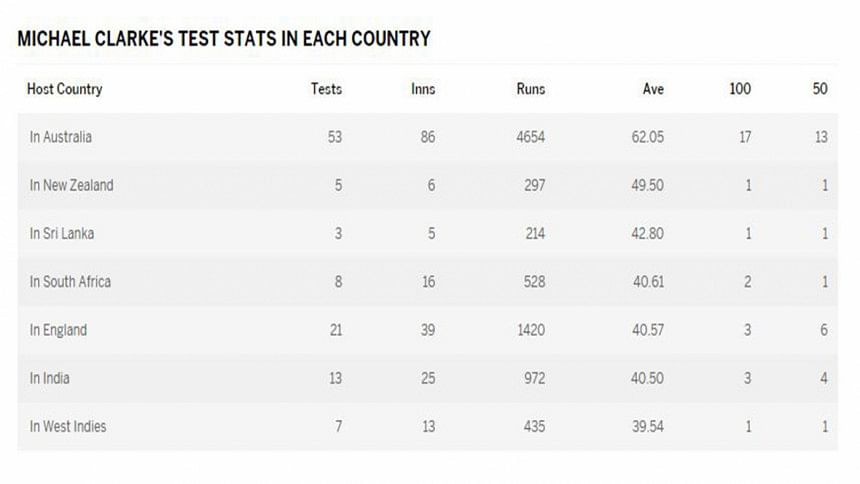
The contrast between No. 4 and No. 5
Throughout his career, Clarke seemed to be at his most comfortable when batting at No. 5. He scored runs by the bucketful when batting at that slot, but strangely seemed to get into a rut when he moved a slot higher, to No. 4. Most middle-order batsmen tend to start their careers at Nos. 5 or 6 and then move up the order as they gain in experience and batting nous, but with Clarke that never really happened, which is perhaps also one of the reasons he isn't quite up there with the batting legends. He did average 45.09 from 24 innings at No. 4 in 2013 and 2014 - a period during which he also scored that 161 not out in Cape Town - but his overall average at that position, in 61 innings, is a mediocre 30.89. Among all batsmen who've played at least 50 innings at No. 4, only one - South Africa's Dave Nourse, who played between 1902 and 1924, has a poorer average.
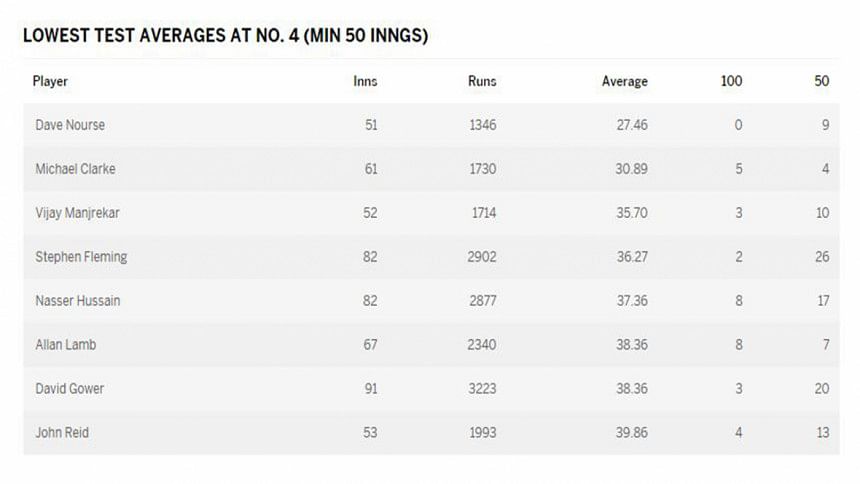
At No. 5 the story is completely different: Clarke averaged an outstanding 60.80 - almost twice his No. 4 average - from 110 innings. With the same 50-innings cut-off, only one batsman, AB de Villiers, has a higher average at that position. Clarke scored a century every 5.5 innings at No. 5; at No. 4, he scored one every 12 innings.
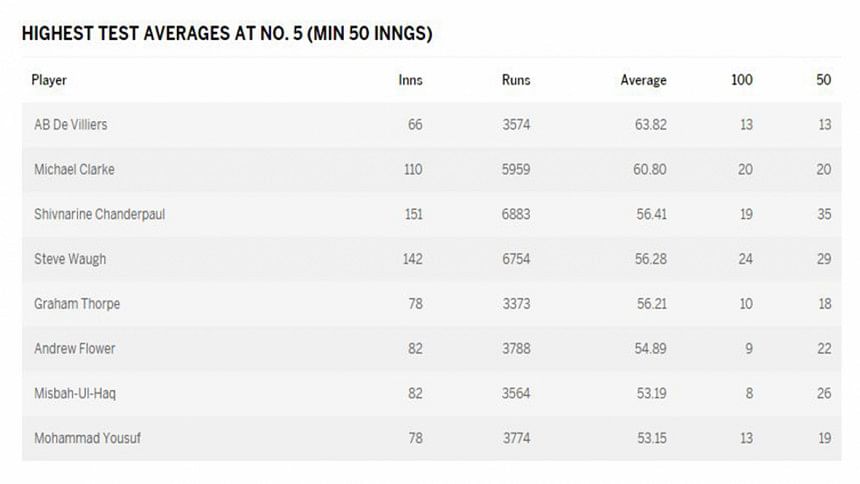
The spin problem
As Aakash Chopra so lucidly explained, Clarke's twinkle-toed footwork suggests he is excellent against spin, but his record against spinners in Asia isn't that impressive. In Asia, he averages 34.84 against spin; outside Asia, his average against spin increases to 66.86. Left-arm spinners have particularly troubled him - his overall average against them is 42.03, and in Asia it drops to 18.57.
Overall, the bowler who has troubled him the most is undoubtedly Stuart Broad, who has dismissed Clarke 11 times at an average of 23.27 runs per dismissal. James Anderson and Dale Steyn have both dismissed him nine times each, Anderson at an average of 33 runs per wicket, Steyn at an average of 28.88.
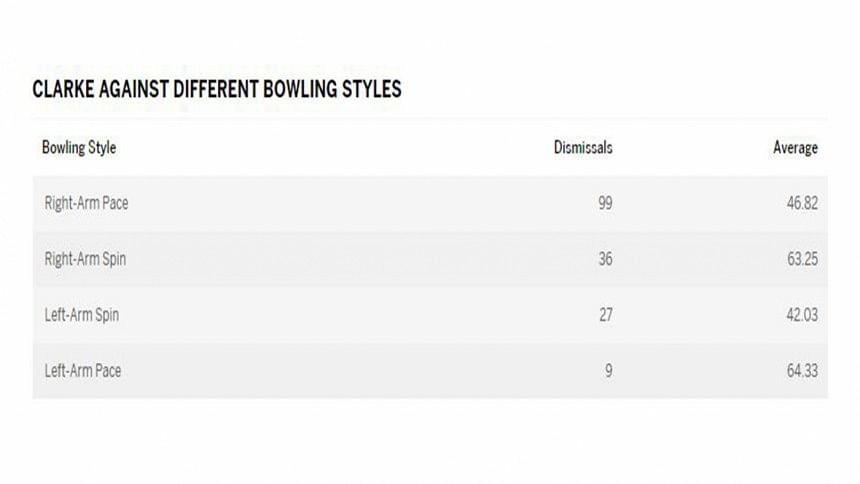
Clarke the captain
In the 46 Tests that Clarke captained, Australia won 23 and lost 16. The win-loss ratio of 1.437 isn't a bad one, but Australia have been such a successful team historically that Clarke's captaincy record is one of the poorest: among the 15 Australian captains who have led in 20 or more Tests, only three have a poorer ratio - Kim Hughes (4-13), Bob Simpson (12-12) and Bill Lawry (9-8). Under his leadership, Australia have lost exactly as many Tests as they did under Ponting, but have won less than half as many - Ponting's Australia won 48 Tests out of 77.
Most pundits agree that tactically, Clarke was superb, attacking at every opportunity and never allowing the game to stagnate. His innovative field settings and bold declarations made him one of the most interesting captains, and perhaps Australia's best tactically since Mark Taylor, but the team itself, and especially the erratic batting, meant that those tactics didn't always convert into wins. Australia's home record under Clarke was outstanding - 14-3, which is fourth among all Australian captains who have led in at least ten home Tests - but overseas they struggled, winning nine and losing 13, a record which puts him in 11th place among 15 captains who've led in ten or more away Tests.
More Numbers
- 151 Clarke's score on Test debut, against India in Bangalore, the sixth-highest among Australians in their first Test. Clarke also notched up a century in his first Test innings at home, scoring 141 against New Zealand at the Gabba in November 2004.
- 4 Double-centuries Clarke scored in 2012, the most by any batsman in a calendar year. His aggregate of 1595 is the fourth-highest by a batsman in a year.
- 14 Centuries Clarke scored in the 46 Tests in which he captained. Only Graeme Smith, Ponting, Border and Waugh scored more hundreds as captain.
- 329* Clarke's score against India in Sydney in 2012, the fifth-highest by a captain in Tests. He is one of eight captains to score a triple-century in Tests.
- 670 Runs scored by Clarke in the fourth innings in his entire Test career, at an average of 31.90. That aggregate is less than 8% of the total runs Clarke scored in his Tests.
- 6/9 Clarke's bowling figures against India in Mumbai in 2004; he is one of only five bowlers to take six or more wickets conceding fewer than ten runs in a Test innings.

 For all latest news, follow The Daily Star's Google News channel.
For all latest news, follow The Daily Star's Google News channel. 



Comments